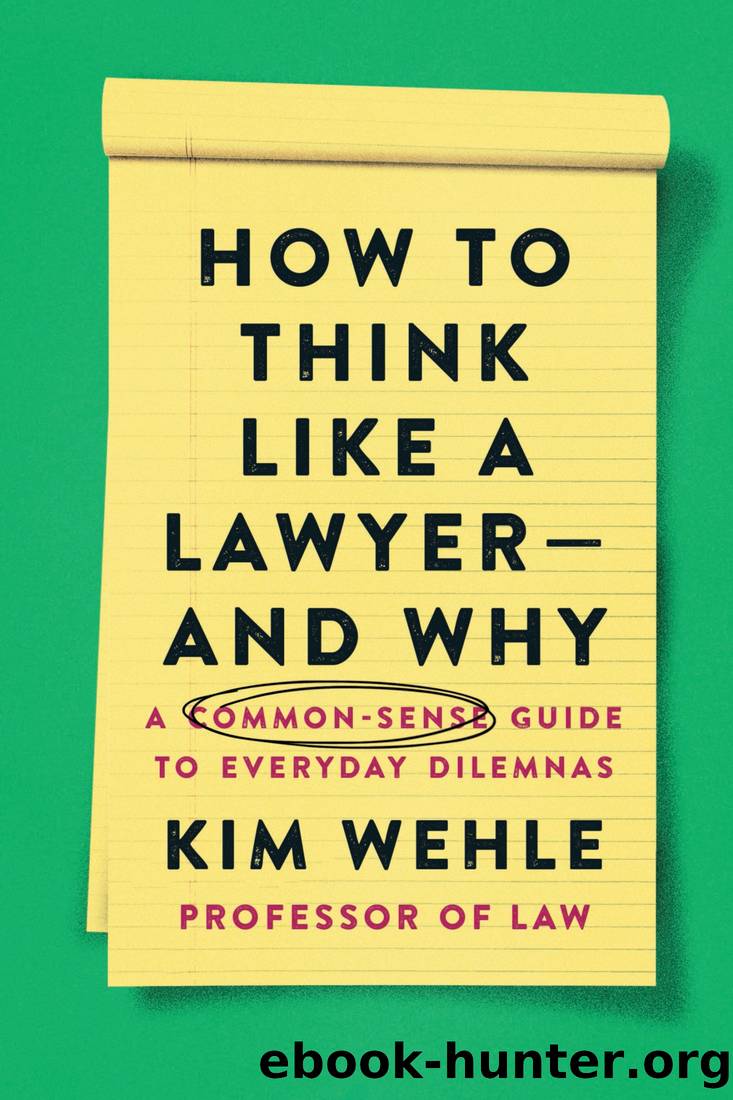How to Think Like a Lawyer--And Why: A Common-Sense Guide to Everyday Dilemmas by Kim Wehle

Author:Kim Wehle
Language: eng
Format: mobi
Tags: Decision-Making & Problem Solving, Education, Constitutions, Negotiating, General, Political Science, Law, Business & Economics
ISBN: 9780063067561
Publisher: HarperCollins
Published: 2022-02-21T21:00:00+00:00
âMy-Sideâ Bias
Think about this lawyerly approach to facts for a moment. Itâs probably fairly different from how many of us make decisions in our everyday lives. When faced with a personal dilemma, we arenât always naturally inclined to dig up both sides of a story. Psychologists call this âconfirmation bias,â and it often gets in the way of getting an accurate picture of things. As I mentioned in the introduction to this book, confirmation bias is the tendency to look for information that reinforces what we already believe, and it can be accompanied by the refusal to listen to facts that contradict our beliefs.
We tend to follow the social media accounts of people who say things that make sense to us. And we might not follow the accounts of people who say things on the opposite side of an issue. The same goes with what kind of news we read. We might only click on or tune into news sites that we know will confirm our point of view. The other side never gets our attention because we donât seek it out. As a result, the âtruthâ can amount to a one-sided version of facts that are carefully (albeit inadvertently) chosen to correspond to an existing set of beliefs.
This lack of curiosity about the other side of the story happens a lot in everyday life. A friend is sure that his spouse is cheating. As âproof,â he points to her lack of interest in him at the end of a workday, or the fact that sheâs constantly on her phone and sometimes chuckles when reading texts, which he assumes is because sheâs flirting with someone else. A co-worker sends an email to your boss. When she doesnât get a reply for a couple of days, she reads the lack of response as confirmation that the boss doesnât like her. This can work in the other direction too. The boss might have passed your co-worker over for a promotion because he assumes that a working mother of young children wonât be willing or able to handle the extra stress that the new job entails. But of course, there are many other possible explanations for each of these scenarios.
This âmy-sideâ bias is entirely normal, but it doesnât necessarily produce the best decisionsâparticularly in complex, risky situations. We act on it because itâs less taxing to us cognitively than pulling apart every issue, diving into it, and then arriving at an independent conclusion. It also just feels better than entertaining an opposing view, which can sting and hurt oneâs self-esteem because it challenges what we believed to be true. None of this is done consciously, which is why itâs important to identify the phenomenon of confirmation bias so we can catch and outmaneuver it when it might matter. If hearing out the other side could lead to a better decision on an issue that we really care about, then practicing Step 3 in the B-I-C-A-T framework is worth the extra effort.
In making civic
Download
This site does not store any files on its server. We only index and link to content provided by other sites. Please contact the content providers to delete copyright contents if any and email us, we'll remove relevant links or contents immediately.
The Secret History by Donna Tartt(18263)
The Social Justice Warrior Handbook by Lisa De Pasquale(11969)
Thirteen Reasons Why by Jay Asher(8490)
This Is How You Lose Her by Junot Diaz(6476)
Weapons of Math Destruction by Cathy O'Neil(5871)
Zero to One by Peter Thiel(5517)
Beartown by Fredrik Backman(5379)
The Myth of the Strong Leader by Archie Brown(5255)
The Fire Next Time by James Baldwin(5040)
How Democracies Die by Steven Levitsky & Daniel Ziblatt(4977)
Promise Me, Dad by Joe Biden(4919)
Stone's Rules by Roger Stone(4879)
100 Deadly Skills by Clint Emerson(4711)
A Higher Loyalty: Truth, Lies, and Leadership by James Comey(4574)
Rise and Kill First by Ronen Bergman(4558)
Secrecy World by Jake Bernstein(4417)
The David Icke Guide to the Global Conspiracy (and how to end it) by David Icke(4414)
The Farm by Tom Rob Smith(4340)
The Doomsday Machine by Daniel Ellsberg(4262)
